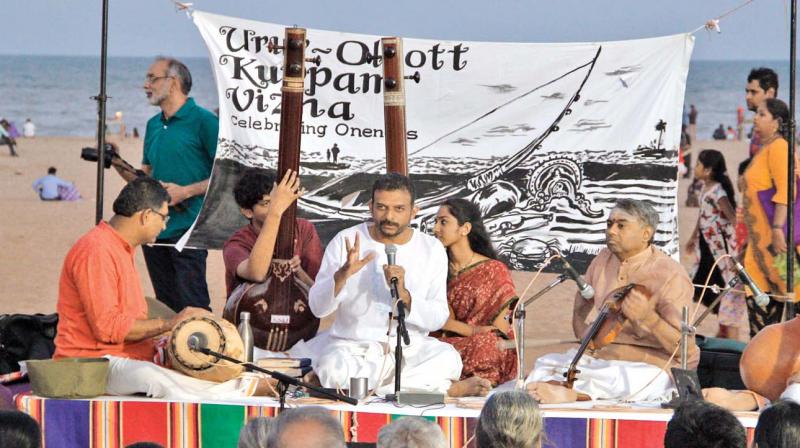Art beyond the four walls

It wasn’t one of those usual evenings at the Elliot’s Beach recently. While the kids waited for their turn to hop in for a giant wheel ride, and the elderly took their evening stroll, a few young men were setting up wooden platforms. Within minutes, Carnatic music permeated through the air, much to the surprise of many. As time went by and more musical renditions followed, the crowd on the beach was visibly polarised — those who did not want to step away from the sea waters remained close to it, there were the kids who wouldn’t give up their turn for the ride, while the others were drawn towards the singer.
Many recognised him as T M Krishna, and decided to find a spot in front of the banner that read ‘Urur-Olcott Kuppam Vizha — Celebrating Oneness’. As the violinist on stage seated next to TMK continued to work his magic, the audience could be seen absolutely at ease. Unlike at a regular Carnatic concert at a sabha, where there is an unsaid pressure for women to be seen in pattu sarees with mallipoo in their braids, and men to keep it as ‘ethnic’ as possible, here, there was space for absolutely any sartorial choice. A lungi, a pair of shorts, a skirt or track pants — to listen to music at one’s comfortable will — and importantly, not be judged for it. One could walk in and out anytime, which is almost unimaginable at a sabha. While the dogs on the beach continued to take their walks amidst listeners, and the cotton candy man’s bells echoed through the space alongside TMK’s singing, one could catch a glimpse of how art in public spaces could be powerful in garnering people’s attention.
The Ramon Magsaysay awardee explained his beach performance and the vizha. “This is an outreach programme, for a festival which aims to create an equal platform for different artforms from classical, non-classical and folk, while bringing people of varied backgrounds together.”
It would be held at the Urur-Olcott Kuppam on February 10 and 11, right behind the Thalapakkati restaurant here. There is no form of corporate sponsorship for this and we would appreciate if you could help with whatever you wish to donate, in the box that Niti (referring to environmental activist Nityanand Jayaraman, who has been a part of bringing the vizha to form) holds,” TMK says, quickly getting back to his next song, Poromboke, with the young ones in the audience, recalling the song, which was trending digitally till recently.
The evening saw a fair bit of dissent through the music, a little bit of tradition through the classical notes, and a major amount of breaking out of the conventions. As the singer wrapped up his singing exactly after an hour clocked, we caught up with him for a chat.
“The vizha took birth out of my questions about art and the platforms it had. While performing during the music festival seasons in the city, I had the idea one day on what it would be like, if a music season happened, say at a kuppam. I met Niti later, and it was then that we decided it would be Urur Olcott Kuppam.
Traditional spaces are not just a place for a singer to perform — they also determine the audience’s texture, who can attend or not, although there is no ‘not allowed’ board. But there is a cultural habituation that has been created by a certain kind of people who have been going to the sabhas, kind of like a club and makes one who doesn’t belong to the club, a little uncomfortable. And that is what we want to break,” the singer explains.
“For the first time because of this vizha, there would be kutcheri goers who would be stepping into Urur-Olcott Kuppam, and for the Kuppam residents, the first time they would interact with people from a sabha space. This is where we hope to open a new window,” TMK adds. With the beaches of Chennai making news of late of violence and unrest, maybe it is time for some art to soothe it.

